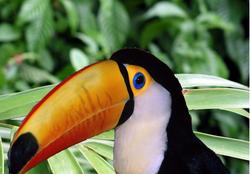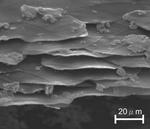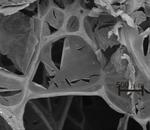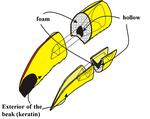Toucan Beaks Are Models Of Lightweight Strength says UCSD engineer
University of California at San Diego release
November 30, 2005
As a boy growing up in Brazil 40 years ago, Marc A. Meyers marveled at the lightweight toughness of toucan beaks that he occasionally found on the forest floor. Now a materials scientist and professor of mechanical and aerospace engineering at UCSD’s Jacobs School of Engineering, Meyers said makers of airplanes and automobiles may benefit from the first ever detailed engineering analysis of toucan beaks conducted in his lab.
“Our computer modeling shows that the beak is optimized to an amazing degree for high strength and very little weight,” said Meyers. “It’s almost as if the toucan has a deep knowledge of mechanical engineering.”
In a paper to be published Dec. 1 in Acta Materialia, Meyers and graduate students Yasuaki Seki and Matthew S. Schneider reported that the secret to the toucan beak’s lightweight strength is an unusual bio-composite. The interior of the beak is rigid “foam” made of bony fibers and drum-like membranes sandwiched between outer layers of keratin, the protein that makes up fingernails, hair, and horn. Just as the hook-shaped barbs on cockleburs inspired the development of Velcro, Meyers said the avian bio-composite could inspire the design of ultra-light aircraft and vehicle components with synthetic foams made with metals and polymers.
“The big surprise was our finding that the beak’s sandwich structure also behaves as a high energy impact-absorption system,” said Meyers. “Panels that mimic toucan beaks may offer better protection to motorists involved in crashes.”
Toucans are highly social, noisy residents of rainforests in the Amazon, although the birds live as far north as Mexico. They use their extremely large and often brightly colored beaks for a variety of purposes, from gathering fruit from the tips of tree branches, to defending themselves.
 UCSD materials scientists discovered that the lightweight strength of the Toco Toucan’s beak is due to a matrix of bony fibers and drum-like membranes sandwiched between an outer layer of keratin, the protein that makes up fingernails, hair, and horn. Images courtesy of UCSD. |
Bird beaks are typically either short and thick or long and thin. The Meyers team decided to prospect for a novel material in toucan beaks because they are both long and thick. Emerald Forest Bird Gardens, a California breeder of exotic birds, provided beaks from toucans that had died from natural causes to Meyers’s team. They analyzed the beaks’ density, stiffness, hardness, and response to compression and stretching. They also examined the beaks with a scanning electron microscope.
The beak’s interior is a highly organized matrix of stiff cancellous bone fibers that looks as if it was dipped into a soapy solution and dried, generating drum-like membranes that interconnect the fibers. The result is a solid “foam” of air-tight cells that gives the beak additional rigidity.
“The beak is mostly air,” said Meyers. “While the inner part of human bone also contains cancellous bone, we don’t have the foam interconnections, which produce a much stronger structure with very little additional weight.”
 The surface of the toucan beak is made of layers of keratin “tiles” that are glued together. |
 The interior of the the toucan beak is a “foam” made of bony fibers and drum-like membranes. |
 The beak has a hollow region in an interior region where the mechanical stresses were insignificant. |
Like a house covered by a shingled roof, the foam is covered with overlapping keratin tiles, each about 50 micrometers in diameter and 1 micrometer thick, which are glued together to produce sheets.
The study in Acta Materialia also noted a hollow region extending about half the length of the upper and lower beaks. “When we did the calculations, we discovered that there are only very insignificant mechanical stresses in the center of the beak at the position of the hollow areas,” said Meyers. “This is why I jokingly tell my students that toucans have a deep knowledge of mechanics. They don’t bother adding structural support in a part of the beak that doesn’t really need it.”
This story is derived from a University of California at San Diego news release. This original version appears at Engineers Discover Why Toucan Beaks Are Models Of Lightweight Strength.
Related articles
Nature’s engineering shows butterfly design innovation (11/18/2005)
Flourescent patches on the wings of African swallowtail butterflies work in a very similar, but more efficient way to high emission light emitting diodes (LEDs) used in electronic equipment and displays, according to University of Exeter research published in Science.
Biomimetics, technology that mimics nature (11-July-2005) Engineers, scientists, and business people are increasingly turning toward nature for design inspiration. The field of biomimetics, the application of methods and systems, found in nature, to engineering and technology, has spawned a number of innovations far superior to what the human mind alone could have devised. The reason is simple. Nature, through billions of years of trial and error, has produced effective solutions to innumerable complex real-world problems. The rigorous competition of natural selection means waste and efficiency are not tolerated in natural systems, unlike many of the technologies devised by humans.
Biomimicry Employed by MIT Nanotechnology Researchers (September 21, 2005) The ocean is a perilous environment for a soft-bodied creature like a sea snail, so nature gives it an advanced nanostructured armor system that is stiff and strong yet lightweight. It’s called a shell. Understanding the fundamental design principles of natural armor systems like shells may help engineers design improved body armor systems for humans in perilous situations, like soldiers and police officers. At MIT’s Institute for Soldier Nanotechnologies, researchers are studying the structure and mechanics of the tough inner layer of mollusc shells, called “nacre” or mother-of-pearl, at extremely small, nanometer-length scales (a nanometer is a billionth of a meter).
Design of new Mercedes-Benz bionic car inspired by fish body shape (10-July-2005) DaimlerChrysler is using a new concept vehicle to examine the great potential of bionics for automobile development, and has achieved outstanding results for fuel consumption and emissions with a combination of pioneering diesel engine technology and innovative emission control methods. The Mercedes-Benz bionic car study will have its world premiere at this year’s DaimlerChrysler Innovation Symposium in Washington.
Nature Provides Design Template for Human Problems (November 1, 2005) Copying the ideas of others is usually frowned upon, but when it comes to the work of Mother Nature, scientists are finding they can use nature as a template. An interdisciplinary group of scientists and engineers at the Georgia Institute of Technology recently formed the Center for Biologically Inspired Design (CBID) with the goal of capitalizing on the rich source of design solutions present in biological processes. The researchers believe nature can inspire design and engineering solutions that are efficient, practical and sustainable and thus have the potential to greatly enhance new technologies, materials and processes.